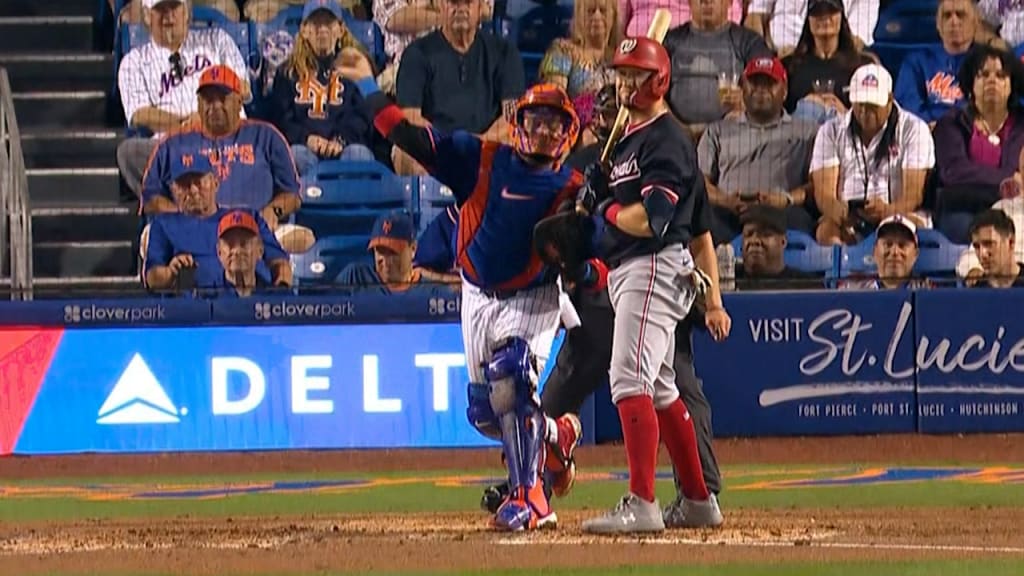Running on Alvarez? That's getting risky
This browser does not support the video element.
TAMPA, Fla. -- Leading the Majors in any spring statistical category tends not to mean much … except on those occasions when it does.
As various teams wrapped up their Grapefruit and Cactus League seasons on Monday -- including the Mets, who fell to the Yankees, 3-0 -- Mets catcher Francisco Alvarez finished atop the leaderboard in runners caught stealing. He had eight. No other catcher had more than five.
“I feel like they can respect me more,” Alvarez said. “They won’t run that much like last year.”
In his first full season as a Major League catcher, Alvarez allowed 99 stolen bases while catching only 15 runners. That was not necessarily abnormal, considering Major League Baseball’s new rules designed to promote action on the basepaths. Yet Alvarez proved particularly easy to run against; his caught stealing rate of 13.2 percent was third worst among 38 catchers with at least 500 innings behind the plate.
That troubled the Mets, particularly considering Alvarez’s natural arm strength. With MLB’s new rules in place, no catcher is going to experience consistent success throwing out runners. (Last year’s league leader, Gabriel Moreno, was successful only 38.6 percent of the time.) But shouldn’t Alvarez have been better than he was?
Turns out the answer was yes. In the early days of Spring Training, Alvarez and catching instructor Glenn Sherlock worked often on Alvarez’s footwork, which both men consider the key to everything. Alvarez begins each pitch with one knee on the ground, but if he sees a runner going, he pops up into a half-squat. That allows him to move more seamlessly into a throwing position.
This browser does not support the video element.
Timing is also crucial. Like most catchers, Alvarez loses accuracy and velocity when he rushes throws. If he takes an extra beat, as he did in cocking his arm and firing to second during a March 19 game against the Cardinals, Alvarez can let his raw abilities do the rest. That throw came out of his hand at 85.8 mph. Last year, Alvarez ranked 13th out of 54 qualified catchers with an average arm strength of 84.8 mph, according to Statcast data.
“He’s got a cannon,” manager Carlos Mendoza said. “But he’s continued to get better.”
This is all part of a continual improvement arc for Alvarez, who understands his defense will be as important as his bat if the 22-year-old wishes to become a superstar. Already one of the league’s top pitch framers, Alvarez likes to wear a T-shirt featuring a cartoon backstop and the phrase “CATCHER FRAMING” in large letters. He has tried to become a better blocker, and he now rates roughly league average in that area. Containing the running game is his next frontier.
“We’ve never had a problem with him working,” Sherlock said. “He loves to work. I would also say that he’s working smarter this year, whereas in the past he felt like more is better. Now, he’s thinking about what he’s doing and being smarter about it.”
The goal, again, is not to eliminate the running game completely. It’s simply to plant a seed of doubt in the minds of would-be basestealers, to prevent them from feeling like they can run with impunity. Last week, Alvarez broke into a wide grin when asked about the feeling of throwing out a runner, which he considers even better than hitting a homer.
“I think a lot of times where catchers get into trouble is when they try to rush their throws -- when they try to be too quick because the runners are getting good jumps,” Sherlock said. “These new rules are geared toward the success of the basestealer, so catchers are rushing. But right now, he’s not rushing. He’s just kind of staying under control.”

